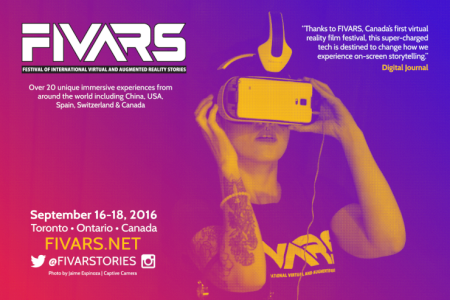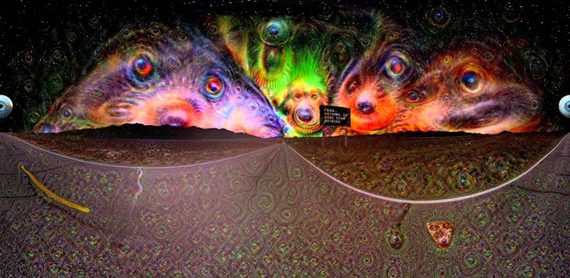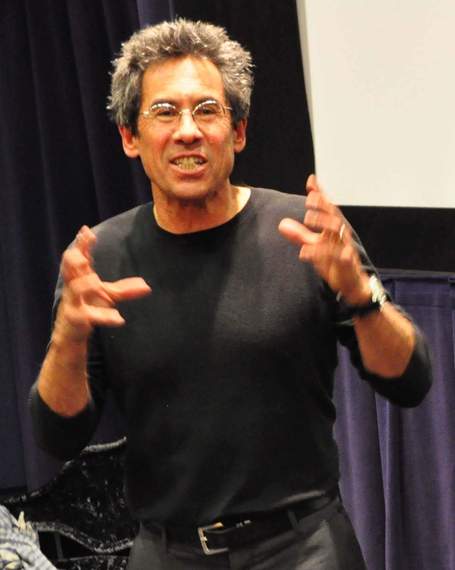
This is a busy weekend in Toronto, but if FIVARS (Festival of International Virtual and Augmented Reality Stories) isn't on your agenda, you're making a mistake.
Over the past two years, the festival -- the first and premier event of its kind -- has featured the most envelope-pushing virtual and augmented reality narratives in the world, and with over 30 pieces on display, this weekend is set to be the most exciting yet.
Immersive media, embodied by plureality technologies like VR and AR, is our most novel storytelling mode. It has already sparked a revolution of creative thinking and united artists from across different art forms (film, gaming, theatre, and more) with a velocity and scale never before witnessed -- all in less than four years. For this medium to reinvent and challenge our expectations of what narrative can be, we need the same revolutionary ethos to guide how we share and exhibit the work we create within it.
That's where FIVARS comes in.
When Founder and Director Keram Malicki-Sánchez, Toronto's tireless, multi-hyphenate futurist, set out to make a space for celebrating superlative immersive stories, he didn't want to simply mimic existing festival formulas. He sought to design a showcase that embraced the frontier possibilities of this new medium from the ground up. As a result, FIVARS is a cutting-edge display for the most innovative storytelling content in the world.
Of course, that all begins by curating work that exemplifies the spirit. In preparation for the FIVARS preview pavilion at VRTO this summer, Malicki-Sánchez explained his selection process:
It's an experimental festival that forces the question of the submitters, "What novel mechanics are you introducing with your project?" It's kind of a jerk thing to ask. Like, "Wow, it's not good enough that I made a good 360 video that tells a good story, now you want me to introduce a unique mechanics to that?" And I say, "Yeah, for sure, try something and fail at it miserably and let's learn from that.
In these early days, even our most talented artists in the medium are figuring out best practices, but in echoing Samuel Beckett's famous advice to "fail better," Malicki-Sánchez is most interested in seeing the work of artists fearless enough to experiment in service of unearthing techniques that will allow them (and others) to craft stories that are distinct to immersive media. Interestingly, he's found that some of the most innovative narrative modes in VR involve ambient storyscapes, such as "Gotthard," which highlights the longest tunnel in the world (57 km!). It's precisely the kind of piece that can only achieve its effect in VR.
"We've seen that a lot of people of all ages really enjoy this piece," said Malicki-Sánchez. "It's something that demonstrates how a really important key to this content is that stories that would otherwise be overlooked actually get our attention long enough for us to discover something outside the mainstream. When the only thing that we pay attention to is the flash and glitter, it creates a mess inside our brains. This format is demonstrating that people are paying attention to seemingly innocuous parts of the world and of life, and by doing so they engage a different part of their awareness, and I think that's good for the mind."
The impact of incorporating not just new tech but new kinds of stories is so much more than an update to our entertainment. It has deep implications about how we engage with information in every aspect of our lives. In other words, immersive media has the ability to literally change how we think.
"From a macro level -- who am I to say -- but I think it will change a certain rhythm with which we currently process and ingest information," said Malicki-Sánchez. "What scares me is how we fly through Facebook feeds, reposting headlines that we haven't gone as far as the second sentence in the article to research, and then move on. VR grabs us and gets us to sit down for a minute. You're completely immersed; you can't multitask when you're in VR. Over time that may be a positive re-anchoring of a sense of self. It really is something that requires your singular focus. How many things can do that anymore for us?"
"DREAMTIME" channels a similar ambience, but instead taps archetypes in the subconscious to create a pyschedelic environment via Deep Dream. Much has been said about immersive media's capacity to share non-linear narratives like these, and this is one of the form's great strengths, but that doesn't mean there isn't space for linearity as well.
"In 'Knives,' Adam Cosco gets away with television-style editing, closeups, insert shots, and wide angles, but puts all the point-of-interest stuff right in front of you, with the secondary information on the sides and the tertiary information behind you, so this is already a demonstration of the medium evolving and understanding ways to do these things better," said Malicki-Sánchez. "Another incredible piece we have is called 'Real' by Connor Hair. 'Real' is about a dystopian future where the protagonist, a young woman, has an addiction to virtual reality. And her real life, where she's got a fading relationship and a distant relationship with her mother, is being supplanted by her in-VR-world paramour, and what they do to really get this across is they have the entire thing inside of an equirectangular frame in mono, which becomes stereoscopic when she puts on her VR headset, and then occasionally goes into full 360 when they want to create a different emotional effect. So they're already playing with the size of the frame and depth maps in a truly unique way. It's very meta, it's really pushing the medium."
Vision is the primary sense involved in virtual reality, but it has become increasingly clear that attention to sound and touch are also necessary in achieving a true sense of presence and physical embodiment. SubPac tactile haptic backpacks will be available at FIVARS to physicalize the vibrations alongside the pieces. Room-scale experiences via HTC Vive, such as "Irrational Exuberance: Prologue" and "The Key," will let users move about in their virtual environment. Others, like Nima Dehghani's "Decompensation," turn immersion into a participatory installation.
"'Decompensation' is an installation piece with five stations -- meaning five seated stations -- each one representing a different stage of the refugee experience," said Malicki-Sánchez. "You go through the different phases by physically relocating yourself along the timeline, and that kind of spatial play is a fascinating approach to creating a virtual reality experience."
Composer David McKevy is bringing his 3D Audio Voyage Chamber.
"This is a multi-speaker black booth that you sit inside of and it tells you a story through nothing but audio, said Malicki-Sánchez. There's no spoken language, it's only sound effect, but it gives you this full-body wash of indication that transports you completely. It's an abstract form of narrative, because it gives you a time and a place and a context for a mood that evolves over time."
Daniel Leighton's interactive augmented reality experience explores the ways an art installation can communicate his lifelong journey with Crohn's disease, which is as much about struggle as it is about finding the beauty in life.
"What's so beautiful about Daniel's pieces is that, though at first glance they seem childlike in their rendering, once you hold the device up in front of them and the figures start to animate and come to life and move off onto the walls, and jelly parts start to float in the air around you, and there are procedurally generated voices whispering that they love you, it's truly transformative and brings to light these ideas that there are constantly invisible elements around us in the ether that are present for us to pick up on," said Malicki-Sánchez. "It's an artificially living dance that you're having with this artwork, and it's allowing you to sit there and engage with otherwise static pieces on the wall and have a relationship with those pieces. Normally people that don't really get into art ask what they're supposed to do with a painting, like, 'I don't get it.' This has the painting explode out and show you its layers, and the more you sit there and consider them -- the longer you do -- the more the emergent behaviors make themselves known to you. It's really amazing."
This gets at something key about immersive media's ability to be a socially connective form. Though many pieces are designed to be witnessed individually, the best generate connection to others, and the most successful festivals in displaying this content will deeply consider this social aspect. Malicki-Sánchez has kept a keen eye on mistakes and successes he and other organizers have made along the way.
"We recognize that there are some problems in public exhibitions of immersive content," said Malicki-Sánchez. "One of the things that's becoming more and more apparent is that the schadenfreude component of it is not so cool. It's created problems where people take pictures of other people and post them - and those people are not necessarily cognizant of the fact that what they're wearing could be a problem and so on and so forth. However, if you remove that social component, that exchange, that observational part, something goes missing. There's definitely a desire to observe others being fascinated, and being wowed, and being transported, there's a kind of associative, visceral connection that's going on there for the observer just as much for the one being observed. And we want to maintain some part of that energetically."
How does FIVARS tip that tightrope?
"We've created dividing cells that are translucent so that you are not explicitly observing the other person but you have a feeling of their a presence and of how they are being effected by this transportive, alternate dimension," said Malicki-Sánchez. "We also have deeper sets for the enter and exit bays of an immersive experience."
Malicki-Sánchez encourages attendees to use the 6000 sq ft environment to process content at their own rate without feeling pressed for time. Tickets afford attendees 30 minutes of viewing time, but a full hour in the space.
"The reason for that is they can either sit and do all 30 minutes at once, consecutively, or they can take breaks, wander around a little bit, let their brains refuel, then go back in," said Malicki-Sánchez. "Because we only sell 20 tickets per hour, there are no lineups. They can come and go at a pace that they desire within that hour."
This also inherently incorporates the social element; for that hour, you're with your individual FIVARS crew - its own sort of "virtual" reality.
"I think there's something really cool about that group of people going in together at that hour," said Malicki-Sánchez. "It's like they've ridden the roller coaster or gone into the jungle together."
The other integral element to FIVARS is its focus on future-forward conversation, embodied in the Saturday and Sunday panels (both from 3pm-4pm) that Malicki-Sánchez will moderate, during which no exhibits or demos will be running. Admission to the panels are included in every ticket, regardless of time slot. Sunday's presentation will feature Dan Yashinksy, who founded (and continues to serve as Director) of the Toronto Storytelling Festival in 1979.
"Dan is coming to speak about the art and tradition of storytelling from a completely non-technological standpoint," said Malicki-Sánchez. "One of the things he and I will discuss is the art of maintaining suspense, and how that relates to creating experiences in VR where everything is constantly exposed. When you've got deep focal lengths and surround video, how do you obfuscate, how do you withhold something to maintain suspense and tension?"
To engage with one of the most knowledgable storytelling minds in the world, Malicki-Sánchez has been reading all sorts of literature in both expected and unexpected places. For instance, he recently read an old GURPS (Generic Universal Role Playing System) module from decades ago about how to create a mystery campaign in a role playing universe, which presents completely different challenges than in something like a novel.
"The author [of traditional fiction] has incredible control over the pacing, the clues you might drop, the number of secondary characters, how the ultimate reveal is offered, and the reader might say to themselves, 'Oh, I thought it was this other person, I got tricked, I didn't seen that coming,'" said Malicki-Sánchez. "But if you're playing a role playing game, AKA creating an interactive environment where there's a give and a take, how do you form a mystery that maintains suspense, how do you drop clues at the right time and at the end allow that person who invested their time not to be ultimately disappointed? They have to have the reward in some way of having succeeded at the quest on which they embarked. So this idea of narrative in an intrinsically interactive medium creates some really interesting challenges, which is why I'm bringing in a master in the craft of storytelling to talk to people who are now venturing into a very difficult medium."
With all these stellar pieces, it might be easy to feel the FOMO kicking in. That's where the FIVARS app comes in handy. Viewers can read about festival pieces in advance to figure out which they'd like to use to fill their 30-minute slot. But it's safe to say that any choice is going to yield an amazing half-hour of immersive wonder.
"We have a very narrow filter so that there's a focus that induces progression and exploration," said Malicki-Sánchez. "It's not like we're the final resting ground for these pieces but rather a propeller to keep learning and refining and exploring."
In looking back at the early days of film, we can see a progression of how filmmaking techniques progressed over time. Similarly, we're in the early days of this new medium, where people are rapidly uncovering and developing new methods of production. One thing Malicki-Sánchez is especially excited about building with FIVARS is a living timeline of immersive media.
"I look at what these people have done, these selections, and I say, 'How special are you guys? You actually came this far. You actually figured out the complexities of how to write stories for this medium and how to start connecting with audiences -- and you're iteratively and recursively figuring out how to improve upon that,'" said Malicki-Sánchez. "Because of that the content is getting better. No longer do we have to deal with things that are nausea-inducing or vertigo-inducing; that was last year's problem. Next we have to look at better acting, better direction, better camera movement, better exploitation of the various opportunities that exist going from different format sizes and dimensionality and interactivity. Next year we'll be miles ahead of what we have today, and yet these stories that we have today are going to be such special gems we have along that path. So by us having that really narrow filter, we create this understandable timeline of how this progression went. In the end, this is not an entertainment showcase. To me, this is a World's Fair of how we are moving toward the Singularity, and into a whole new paradigm of technology and expression and human augmentation that will render the past quaint and irretrievable."
FIVARS is a revolutionary festival of the future; it's exactly the kind of showcase virtual and augmented reality deserve.




